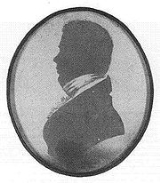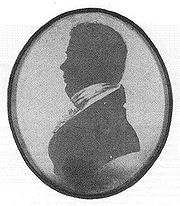
Fearon Fallows
Encyclopedia
Fearon Fallows was an English
astronomer
.

in Cumbria
, the son of John Fallows, a weaver, and his wife Rebecca. Due in some part to the dedication of his father and the generosity of the townspeople, the scholarly Fearon was given the funds to attend St John's College, Cambridge
, where he studied mathematics
, coming third in his year when he graduated in 1813.
He obtained his Master of Arts in 1816 and went on to teach mathematics at Corpus Christi College, Cambridge
. He also became a Fellow of St John's College, Cambridge
and an ordained priest in the Church of England
. On 29 February 1820 he was elected a fellow of the Royal Astronomical Society
and on 8 June 1820 he was granted a fellowship of the Royal Society
. One of his proposers for his fellowship to the Royal Society was John Herschel
(son of William Herschel
) whom he met at St John's College, Cambridge
. Later in that year he was appointed by the Admiralty
to be the astronomer
at the Cape of Good Hope
, which would involve overseeing the building of an observatory in what was then a British colony.
Before travelling to South Africa
, he married Mary Anne Hervey, on 1 January 1821.
Between 1821 and 1829 he worked to site, plan and develop the observatory, which was the first astronomical observatory in the southern hemisphere. He also served the Church of England
in his time there.
He, and all the observatory staff, caught scarlet fever in 1830 and, still Director of the observatory, he died of scarlet fever
in Simon's Town
, South Africa
in 1831 at the age of forty-three.
in South Africa
.
When he first arrived, he only had two portable instruments and a clock, perhaps a Harrison clock. The instruments were a Circle and a Transit Instrument. When the observatory was built, he used a Jones Mural Circle and a Dolland Transit Circle.
The Royal Society published his 'Catalogue of 273 Stars' in 1824.
English people
The English are a nation and ethnic group native to England, who speak English. The English identity is of early mediaeval origin, when they were known in Old English as the Anglecynn. England is now a country of the United Kingdom, and the majority of English people in England are British Citizens...
astronomer
Astronomer
An astronomer is a scientist who studies celestial bodies such as planets, stars and galaxies.Historically, astronomy was more concerned with the classification and description of phenomena in the sky, while astrophysics attempted to explain these phenomena and the differences between them using...
.

Life
He was born in CockermouthCockermouth
-History:The Romans created a fort at Derventio, now the adjoining village of Papcastle, to protect the river crossing, which had become located on a major route for troops heading towards Hadrian's Wall....
in Cumbria
Cumbria
Cumbria , is a non-metropolitan county in North West England. The county and Cumbria County Council, its local authority, came into existence in 1974 after the passage of the Local Government Act 1972. Cumbria's largest settlement and county town is Carlisle. It consists of six districts, and in...
, the son of John Fallows, a weaver, and his wife Rebecca. Due in some part to the dedication of his father and the generosity of the townspeople, the scholarly Fearon was given the funds to attend St John's College, Cambridge
St John's College, Cambridge
St John's College is a constituent college of the University of Cambridge. The college's alumni include nine Nobel Prize winners, six Prime Ministers, three archbishops, at least two princes, and three Saints....
, where he studied mathematics
Mathematics
Mathematics is the study of quantity, space, structure, and change. Mathematicians seek out patterns and formulate new conjectures. Mathematicians resolve the truth or falsity of conjectures by mathematical proofs, which are arguments sufficient to convince other mathematicians of their validity...
, coming third in his year when he graduated in 1813.
He obtained his Master of Arts in 1816 and went on to teach mathematics at Corpus Christi College, Cambridge
Corpus Christi College, Cambridge
Corpus Christi College is a constituent college of the University of Cambridge. It is notable as the only college founded by Cambridge townspeople: it was established in 1352 by the Guilds of Corpus Christi and the Blessed Virgin Mary...
. He also became a Fellow of St John's College, Cambridge
St John's College, Cambridge
St John's College is a constituent college of the University of Cambridge. The college's alumni include nine Nobel Prize winners, six Prime Ministers, three archbishops, at least two princes, and three Saints....
and an ordained priest in the Church of England
Church of England
The Church of England is the officially established Christian church in England and the Mother Church of the worldwide Anglican Communion. The church considers itself within the tradition of Western Christianity and dates its formal establishment principally to the mission to England by St...
. On 29 February 1820 he was elected a fellow of the Royal Astronomical Society
Royal Astronomical Society
The Royal Astronomical Society is a learned society that began as the Astronomical Society of London in 1820 to support astronomical research . It became the Royal Astronomical Society in 1831 on receiving its Royal Charter from William IV...
and on 8 June 1820 he was granted a fellowship of the Royal Society
Royal Society
The Royal Society of London for Improving Natural Knowledge, known simply as the Royal Society, is a learned society for science, and is possibly the oldest such society in existence. Founded in November 1660, it was granted a Royal Charter by King Charles II as the "Royal Society of London"...
. One of his proposers for his fellowship to the Royal Society was John Herschel
John Herschel
Sir John Frederick William Herschel, 1st Baronet KH, FRS ,was an English mathematician, astronomer, chemist, and experimental photographer/inventor, who in some years also did valuable botanical work...
(son of William Herschel
William Herschel
Sir Frederick William Herschel, KH, FRS, German: Friedrich Wilhelm Herschel was a German-born British astronomer, technical expert, and composer. Born in Hanover, Wilhelm first followed his father into the Military Band of Hanover, but emigrated to Britain at age 19...
) whom he met at St John's College, Cambridge
St John's College, Cambridge
St John's College is a constituent college of the University of Cambridge. The college's alumni include nine Nobel Prize winners, six Prime Ministers, three archbishops, at least two princes, and three Saints....
. Later in that year he was appointed by the Admiralty
Admiralty
The Admiralty was formerly the authority in the Kingdom of England, and later in the United Kingdom, responsible for the command of the Royal Navy...
to be the astronomer
Astronomer
An astronomer is a scientist who studies celestial bodies such as planets, stars and galaxies.Historically, astronomy was more concerned with the classification and description of phenomena in the sky, while astrophysics attempted to explain these phenomena and the differences between them using...
at the Cape of Good Hope
Cape of Good Hope
The Cape of Good Hope is a rocky headland on the Atlantic coast of the Cape Peninsula, South Africa.There is a misconception that the Cape of Good Hope is the southern tip of Africa, because it was once believed to be the dividing point between the Atlantic and Indian Oceans. In fact, the...
, which would involve overseeing the building of an observatory in what was then a British colony.
Before travelling to South Africa
South Africa
The Republic of South Africa is a country in southern Africa. Located at the southern tip of Africa, it is divided into nine provinces, with of coastline on the Atlantic and Indian oceans...
, he married Mary Anne Hervey, on 1 January 1821.
Between 1821 and 1829 he worked to site, plan and develop the observatory, which was the first astronomical observatory in the southern hemisphere. He also served the Church of England
Church of England
The Church of England is the officially established Christian church in England and the Mother Church of the worldwide Anglican Communion. The church considers itself within the tradition of Western Christianity and dates its formal establishment principally to the mission to England by St...
in his time there.
He, and all the observatory staff, caught scarlet fever in 1830 and, still Director of the observatory, he died of scarlet fever
Scarlet fever
Scarlet fever is a disease caused by exotoxin released by Streptococcus pyogenes. Once a major cause of death, it is now effectively treated with antibiotics...
in Simon's Town
Simon's Town
Simon's Town , sometimes spelled Simonstown; is a town in South Africa, near Cape Town which is home to the South African Navy. It is located on the shores of False Bay, on the eastern side of the Cape Peninsula. For more than two centuries it has been an important naval base and harbour...
, South Africa
South Africa
The Republic of South Africa is a country in southern Africa. Located at the southern tip of Africa, it is divided into nine provinces, with of coastline on the Atlantic and Indian oceans...
in 1831 at the age of forty-three.
Astronomical work
He was the astronomer to King George IV, and catalogued over 300 stars from his observatoryObservatory
An observatory is a location used for observing terrestrial or celestial events. Astronomy, climatology/meteorology, geology, oceanography and volcanology are examples of disciplines for which observatories have been constructed...
in South Africa
South Africa
The Republic of South Africa is a country in southern Africa. Located at the southern tip of Africa, it is divided into nine provinces, with of coastline on the Atlantic and Indian oceans...
.
When he first arrived, he only had two portable instruments and a clock, perhaps a Harrison clock. The instruments were a Circle and a Transit Instrument. When the observatory was built, he used a Jones Mural Circle and a Dolland Transit Circle.
The Royal Society published his 'Catalogue of 273 Stars' in 1824.

